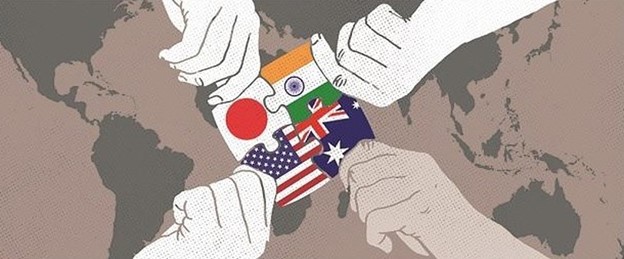Introduction
The Quad is an informal strategic dialogue between India, Australia, Japan and the United States with a shared objective to ensure and support a “free, open and prosperous” Indo-Pacific region. On 12th March 2021, representatives from these nations met virtually for the first Quad summit. In the summit, the Quad alliance aimed to concentrate on the provision of public goods in the vast Indo-Pacific littoral focusing beyond maritime security. They spoke about the need for cooperation among the member countries to deal with the ongoing COVID-19 pandemic through joint partnership on vaccines and stressed the necessity of ensuring an ‘open’ and ‘free’ Indo-Pacific region as their primary objective. This summit was important not only because the members meeting for the first time since the idea was floated in 2007 but, it is also monumental because it signals a shift towards the West in India’s foreign policy which has stood proud over its non-aligned status since Independence. Hence, I will be assessing in this article whether this shift is real or is a way of advancing national interests through hedging.
India’s way: Non-Alignment
Non-alignment was a policy fashioned during the Cold War, to retain the autonomy of policy (not equidistance) between two politico-military blocs. It provided the newly independent nations from contrasting groups- who were either in proximity or dependent on one or the other bloc- an opportunity to protect their autonomy. Thus, Non-alignment emerged to be a tenet in foreign policies of such nations especially India.
But with the end of the Cold War and disbanding of the Soviet bloc, India was able to diversify its network of relationships across the erstwhile east-west divide without any hindrance to their autonomy. Thus, Non-alignment lost its relevance, and NAM its original reason for existence in India’s foreign policy
Signals of shift?
In recent years, non-alignment has not been projected explicitly by our policymakers as a tenet of India’s foreign policy with India’s External Affairs Minister, S. Jaishankar recently saying that non-alignment was a concept of relevance in a specific era and a particular context. However, we have not yet found a universally accepted cornerstone of our foreign policy. Successive formulations have been coined and rejected. Strategic autonomy was one, which soon acquired a connotation similar to non-alignment. Multi-alignment had not found universal fervour, since it had conveyed the impression of opportunism, whereas India attempted to seek strategic convergences. Seeking issue-based partnerships or coalitions was a description that had not stuck. But the regular incursions from the Chinese side seems to have made a major change.
The bitter standoffs with China in recent years-especially after the Galwan Valley standoff in 2020- forced India to recalibrate its external engagements. India embarked on a major foreign policy overdrive from Look East to Act East by bringing its vision for a rules-based Indo-Pacific as a cornerstone of its diplomacy and displaying a steely resolve to fashion a regional environment conducive to its strategic interests. It mounted a diplomatic push focusing on boosting ties with major nations in the West like the US, Japan, the UK and France, with a larger goal to increase its geopolitical heft and position itself as a credible force wedded to peace, stability and international law in contrast to China’s transgression attempts. India’s engagement with western powers is nothing new but what is a remarkable change in the trajectory of India’s non-alignment is its openness to engage in potential military alliances.
The role played in revival in 2017 and subsequent joining of the Quad by India is a signal to India being open to potential military engagements with the West. In November 2020, the navies of Australia, India, Japan and the United States held their biggest naval drills this month, sending warships, submarines and aircraft to the Indian Ocean, in a move analysts said signalled the four countries’ seriousness in countering China’s military and political influence in the Indo-Pacific region. This expansion of the Malabar exercise that began in 1992 as a bilateral exercise between India and the US to Japan in 2015 and then Australia joining the exercise for the first time since 2007 The Quad is only one recent instance in India’s shifting alignments. Besides the Quad, India resolved the remaining issues that had prevented implementation of the historic 2008 Indian-U.S. nuclear deal, renewed the 2005 agreement for defence cooperation, and signed the so-called foundational defence agreements such as BECA(Basic Exchange and Cooperation Agreement) in October 2020 that have facilitated interoperability between the two country’s armed forces sending a strong signal of commitment to the West that India might be ready for a permanent military alliance keeping aside its famed non-aligned status.
But, India’s refusal of Japan’s suggestion to allow ASEAN in the supply chain trilateral and its confirmation to participate in the Shanghai Cooperation Organization(SCO)’s Pabbi Anti-Terror Exercise conveys a different story. This comes as a shock especially to the US as it is not only very keen to cover the lost ground in Southeast Asia that has been showing a deep gravitational shift towards Beijing since 2017 but also it puts doubt over the push for a formal alliance with India. For us, it is a sign that India is not looking for any permanent alliance with the West but it is hedging to try and balance China’s power in South and Southeast Asia to ensure that India’s capability to advance its national interests is secured.
Conclusion
Though non-alignment policy might be dead it seems that the independence of action that was enshrined in it seems to be the driving cog of India’s foreign policy. India’s membership of the Quad should for now be rather seen as an intersection of India and the West’s self-interests with no formal alliance on cards. It should only be seen in the way as Dr Jaishankar aptly puts it in his book The India Way, that Indian grand strategy in an uncertain world requires “advancing [its] national interests by identifying and exploiting opportunities created by global contradictions” so as “to extract as many gains from as many ties as possible”
Pratul Chaturvedi is a second-year student at Ashoka University, who is pursuing History & International Relations.

